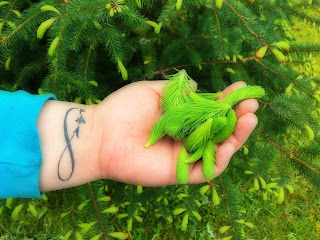Spruce Tips: A Touch of Spring in Winter
In Alaska many of us spend all spring and summer harvesting foods so we can enjoy good food and nutrition all winter. We enjoy salmon, halibut, deer, moose, shrimp, and crab. The usual. Food is a fantastic tool for cross-cultural experiences and education. I would love to see a history book of foods in Alaska, but I am a foodie. If I could eat my way across the planet, I would. As an Alaska Native it’s interesting to watch our traditional foods become popular among non-Native people, even the not so common foods such as spruce tips, devil’s club, seaweed, Labrador tea, salmonberry shoots, and more.
Spruce tips are one of Planet Alaska’s favorites. Eating spruce tips in the winter gets us really excited for spring. It’s one of those foods that makes wonderful memories. When I was young, my mother and I would often pick spruce tips, nibbling and enjoying their lemon-zesty flavor as we hiked around Wrangell until the tips began to mature and were too woody to eat.)
Being a tour guide, I often get asked, “What’s a spruce tip?” Some people, even locals, are new to the spruce tip experience and wonder why we would eat them. Well, spruce tips are high in Vitamin C, chlorophyll, and carotenoids; rich in minerals such as potassium and magnesium; and they also taste great.
 A lot can be done with spruce tips, but my favorite way to eat them, like many foods, is fresh and in season. I love their sprucey flavor. In order to enjoy the tips in the winter they need to be frozen or dried, though the flavor can change a little bit. Blanching spruce tips can help temper the astringency. (Many of these options can also be done with pine and fir tips.)
A lot can be done with spruce tips, but my favorite way to eat them, like many foods, is fresh and in season. I love their sprucey flavor. In order to enjoy the tips in the winter they need to be frozen or dried, though the flavor can change a little bit. Blanching spruce tips can help temper the astringency. (Many of these options can also be done with pine and fir tips.)
Numerous ways to consume spruce tips:
1. Season meals by adding them to soups, stews, and pasta. (Think of spruce tips like rosemary.)
2. Sautéed with other veggies
3. Pesto
4. Tea (Helps with coughs and respiratory ailments.)
5. Smoothies
6. Salads
7. Infused water
8. Candied
9. Baked in cookies and breads.
*We love what we call spruce tip decolonized cookies (also known as Russian teacakes).
10. Syrup
11. Jelly
12. Beer
13. Salt
14. Sugar
15. Vinegar
16. Sorbet
Spruce tip tips
Spruce tip tips
• The main thing to consider is that spruce tip harvesting for our elders is an important part of many Alaskans’ traditions. Consider taking an elder with you or harvesting for elders who cannot get out any more. Spruce trees in Lingít (Tlingit) are called shéiyi, and the big ones are called seet. The needles are called ghítghaa. Consider taking the children in your family so that they can learn too. It is important to pass on ways of living off the land respectfully.
• There is a small window of opportunity to pick spruce tips and it varies from region to region, year to year, but basically from the end of April through mid-May. If you wait too long the tips will turn woody, eventually lengthening the tree branch. Begin harvesting at sea level and as spring progresses harvest higher up in elevation. However, in winter you can break or saw off a small branch and boil it up for your dietary spruce needs.
• Alaskans harvest spruce tips from a variety of spruce trees: Sitka spruce, blue spruce, white spruce, etc. It’s okay to mix your tips. Go ahead and experiment with flavors and types.
• Please harvest respectfully, which means thanking the tree for giving its tips and paying careful attention to pulling or pinching the tip from the tree. Some traditional foods harvesters first ask permission to harvest from the tree. We typically say gunalchéesh (thank you in Lingít) several times while picking spruce tips. And because springtime means that bears are waking up and likely in the neighborhood, you could announce yourself with something like “Grandmother or grandfather, we are just out gathering today. Thank you for giving us space.” Also, don’t take all the tips from one tree: always pick in moderation.
*(Our Spruce Tips first appeared in First Alaskans Magazine)
Suggested spruce tip harvesting practices:
Make sure you’re harvesting in an area away from industrial areas or soils that could be contaminated. Don’t harvest from trees less than 10 feet tall. Only harvest from the lower 1/3 part of the tree. Of the 1/3 of the tree, harvest less than 1/4. Don’t take all the spruce tips from one branch. Just take one or 2. Here in Southeast Alaska we have lots of spruce trees so there is no need to take too much from a tree. If it looks like an area has been harvested by others, simply move on to an area that is not being harvested.
Here are some easy recipes to begin experimenting with this coming spring. If you already have spruce tips in your freezer you can try some of these.
Spruce Tip Vinegar
2 cups of white wine vinegar
1 cup of chopped fresh spruce tips
1 tsp of peppercorns
Combine ingredients into a glass container such as a mason jar. Simply put the lid on and let it soak for 10 days at room temp. Strain your vinegar into a glass container.
Spruce Water
Spruce Tips
Water
Glass Container
Fill a mason jar or other glass container a quarter to half full of spruce tips depending on your preferred intensity of the flavor of spruce. (Don’t use plastic containers.)
Fill with water to the top.
Put the lid on and let it soak anywhere from 4-12 hours. (Taste it along the way. This will help you find how much flavor of spruce you like. Some like a light flavor. We like our water very sprucey.)
Drink as is or experiment with adding lemon, lime, or sugar.
(It is important to note that spruce water tastes best when fresh. If you let the water sit for days you will taste it beginning to turn. Spruce water also tastes best with spring-time spruce tips but if you can’t wait till spring you can go get a small amount of branches and make this in the winter too. The natural sweetness you find in spring tips won’t be there so you may want to add a little sugar.)
Spruce Tip Aioli
1 cup of mayonnaise
1/4 cup of finely chopped spruce tips
1 small clove of garlic (or large, if you love garlic)
1 pinch of salt
Small bowl
Stir all the ingredients together into the bowl. Cover and refrigerate for 1 hour before serving. This allows the flavors to come together.
I hope you’re interested in expanding your palate with this local food. Harvesting enough spruce tips in the spring for your winter needs is an important part of our Alaskan food traditions. Most importantly, I encourage respect and the sustainable harvest of our spruce tips. We can share them with our elders in the winter. We can make food for our cultural events. A drink of spruce tip water in the winter can keep you going in the dark days; and at the very least, get you excited for spring.
** About Vivian Mork Yéilk’: I was born in Wrangell, Alaska and live on my boat in Sitka. I’m Tlingit, a Raven from the T’akdeintaan clan, Snail House from Hoonah. My Tlingit name is Yéilk’ (Cute-Little-Raven). I come from a large multi-cultural family, which is also Sámi, Hawaiian, Chinese, and Irish. I have an M.A. in Cross Cultural Studies with an emphasis in Indigenous Knowledge Systems.
I’m a tourist guide, a traditional food and medicine specialist, a storyteller, a writer, a carver, a tinkerer, as well as a Tlingit language and cultural educator. I grew up exploring Southeast Alaska’s islands in a commercial fishing family, spent my young adult life as a professional vagrant exploring the world, and I now spend a lot of time moving stuff around on my boat in Sitka. (For more about Vivian's work see Planet Alaska , a Facebook page she co-hosts with Vivian Faith Prescott). Vivian hosts the Alaska Traditional Medicinals FB page.












Comments